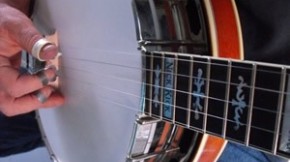Relaxing when playing banjo
How Not to Tense Up Playing Banjo - How to Relax
Special Banjo Instructor Advice Column - Getting in the Zone!
Student Question
Getting in the Zone! By Ross Nickerson
I had a very nice email that included compliments on my book The Banjo Encyclopedia. The student also had some interesting comments that inspired an impromptu email I sent back to him with some suggestions and insights that might help some of you as well. Thanks! Ross Nickerson.
......Dear Ross,
I have been reading through several pages of your "Banjo Encyclopedia," and, I've got to say this is a pinnacle text. Over the years, I've collected dozens of instructional books, almost all of which I set aside after realizing they were not comprehensive...just tabs. You've done it! I feel you passion in your text, and in your playing. You have done the "banjo world of players" a great service...cudos!
Wow! Thanks for the compliments. I am always on to the next project and spend most of my time thinking about how I can improve everything I do rather then enjoying any successes I've had behind me, so thank you, again.
Ross Nickerson response
One of the things that I notice with my private students is that they can think too hard, which many of us do. Adults in particular are used to solving their problems with their mind. With the banjo, many of the difficulties in learning can be solved by overcoming physical barriers. That of course is not new, but it's possible that you may not have thought that concept through clearly.
Good banjo playing in its rawest form really boils down to the banjo player producing a good rhythm, having developed his or her physical skills, with the ability to relax and play effortlessly. All of these problems are solved more easily with repetition, learning to play in time without stopping for mistakes, and you could say, shutting off the mind long enough to pull it off. It's not easy to have enough discipline to keep it simple and steady without pausing or stopping to fix mistakes. But to accomplish it, you many need to "get in a zone" where you are focused on rhythm, simplicity, and repeating exercises over and over long after you have mentally learned the correct notes or strings to play.
I'm not sure how what I just said makes sense to you, but here are some simple suggestions.
Simplify what you play and work on tone and rhythm. Listen carefully, and learn to count.
Perfect or improve your sliding, hammering-on and pulling off techniques. These are techniques that are learned early, but often aren't worked on enough or played with enough attention to how they sound.
Work on your playing ability by simply playing the chords to the songs you know using solid Scruggs Style rolls in a steady continuous rhythm. While changing chords, add in sliding, hammering-on and pulling off techniques. You could also use sample chord progressions (for instance, playing two measures each of G D F C over and over). Make up your own tunes as you do it, simply changing chords produces a melody of some kind.
Memorize your tablature and practice it without looking at the music, even if it is just a short phrase or one measure.
Work on developing some picking speed.
Exercise your fretting hand often with challenging exercises that will develop your flexibility and coordination.
I hope my insight or suggestions help some. There are many exercises for picking and fretting along with memorizing tips, how to play by the chords, and other helpful hints that you can work with too included in "The Banjo Encyclopedia".
Good Luck with your practicing and progress!
If you'd like to submit a question to be used in the column please email me at help@banjoteacher.com
Thanks again,
Sincerely,
Ross Nickerson
( )==='==~








